Arctic Cat Kitty Cat
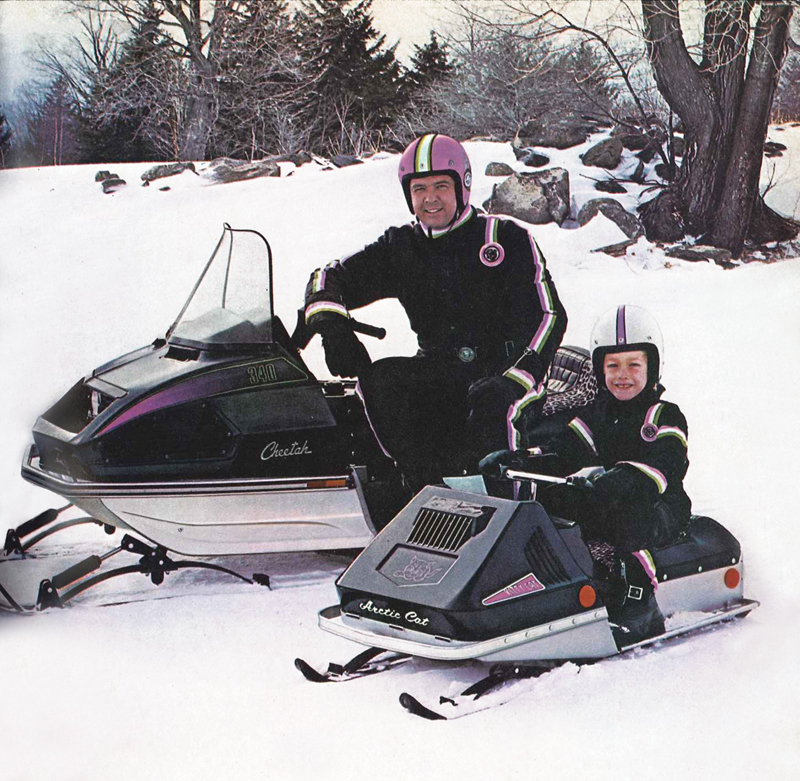
The second annual USSA World Series of Snowmobiling was held in March, 1971, in Boonville, New York. But race sleds weren’t the only snow machines in the public eye that weekend, as the pint-sized Arctic Cat Kitty Cat was unveiled to the public.
Although youth-sized snowmobiles had been around for several years, the new Cat for kids was aimed at an even younger crowd, the 5- to 10-year-olds. Crammed full of safety features and restricted to a top speed between 8 and 12 mph, depending on where the engine governor was set, the Kitty Cat clearly wasn’t a real trail sled but more of a motorized toy for the back yard.
Arctic officials emphasized that the Kitty Cat was small enough to go in the trunk of a car, yet it was styled to look just like a big Cat, right down to its molded plastic hand controls, black hood and Arctic trademark spotted vinyl seat cover over the high-density foam seat. The price was initially announced as “about $250.”
Little did anyone know at the time that this unique machine would become a snowmobile icon for decades to come, and the most successful kid sled ever built. It would also be the machine that introduced many sledheads into the sport — from average Joe trail rider to mountain riders to championship-winning snowmobile racers.
Arctic Cat Kitty Cat Production
The pilot-build of approximately 50 Arctic Cat Kitty Cats, including the one shown at Boonville, used a Clinton two-cycle engine under a non-functional chrome hood grille with trim decals that were patterned after the 1971 EXT race sleds.
The production models released for the 1972 season had many changes. Most obvious was a Kawasaki engine, just like big brother Cat sleds, with the choke relocated from the now smaller dash panel to under the hood where little hands wouldn’t find it so easily. The hood lost the chrome grille in favor of a molded-in black one, but gained side louvers. The belly pan switched from metalflake silver to plain gray.
The chassis was heavily reworked with a different bulkhead, improved hood hinge, redesigned steering and skis, and deletion of the tubular rear bumper in favor of an integrated plastic lift handle and reflector unit. An engine kill switch was added, just like on the big sleds, and new triangular hood decals were used. And in addition to Arctic Cat black, they were also produced with hoods in a choice of red or yellow (50 of each) to appeal to families who owned other brands of sleds.
Initial production was at Arctic’s recently acquired General Leisure lawnmower plant in Omaha, Nebraska, with the retail price set at $269.95 plus freight. Promotion included a ton of product publicity in snowmobile magazines and demos at many snowmobile events.
Small as it was, the Arctic Cat Kitty Cat wasn’t the bottom end of the Arctic Cat line up. That distinction went to the House Cat; a plastic inflatable “snowmobile” introduced a short time after the Kitty Cat. Its propulsion was by the leg muscles of the toddlers it was designed to indoctrinate and prepare for the big move up to the gasoline-powered Kitty Cat.
Arctic Cat Kitty Cat On The Snow
The tiny machine was an instant hit. Even though the Kitty Cat was an expensive toy that was helpless in any kind of serious snow, families eagerly snapped them up for their youngsters. Their low speed and solid construction kept them running for years. It was incredible how much abuse they could absorb. My touring buddy Ted Perkins has a funny video of his 7-year-old son driving his Kitty Cat flat out into on a cinderblock house foundation. Sled and helmeted rider simply shrugged off the impact without damage to either one. Another of my buddies bought one for his 5-year-old son, but his 2-year-old kept jumping on it and riding it away any time his older brother abandoned it even momentarily.
Many Kitty Cats were passed down from one sibling to another, and then eventually sold for use by other families. Once the initial depreciation hit had been absorbed, the little sleds maintained their value amazingly well. The only serious maintenance issue was the inevitable track deterioration from age and use.
Kitty Cat racing was added to all kinds of snowmobile events, and it was amazing how almost everyone would stop whatever they were doing to watch the rug rats run their Kitty Cats. More than a few winning racers got their start in competition this way.
Arctic Cat Kitty Cat Changes
The Cat for kids evolved quite a bit over the years. The alternate hood colors were dropped after the first year and the fuel tank went from metal to plastic in 1973. Graphics and trim began evolving in 1976 and changed considerably over time, getting extensive and very colorful in later years. One of the biggest changes occurred in 1977 when the Suzuki AA06A1 60cc engine replaced Kawasaki power, one year after the same engine supplier change in the big Cats. The carburetor was eventually changed to a Mikuni butterfly type. A handlebar pad became standard equipment in 1979. Unfortunately, Arctic Enterprises went out of business in 1981, so no Kitty Cats were built for the 1982, ’83 or ’84 model years.
Arctco Inc., the successor to Arctic Enterprises, began building Kitty Cats in 1985. This later series included an always-on headlight and a windshield as standard equipment. Both were previously available as options. Other materials changes later in life included switching to a steel chassis with an ABS hood. A real rear bumper was added in 1995.
Production ran through the 2000 model year when the new, larger and more capable four-stroke Z 120 pushed the then $1,349 Kitty Cat aside.
Arctic Cat Kitty Cat Legacy
The Kitty Cat proved to be the most popular and longest lasting of the more than half-dozen snowmobiles built specifically for kids over the years, and it paved the way for the later 120-class sleds from Arctic Cat and others.
Many Arctic Cat Kitty Cats are still entertaining tiny tykes across the Snowbelt and preparing them to participate in snowmobiling as an adult. Some of them sell for more than their original list price, so many are likely to be around as long as there are tracks available to keep them moving. And that makes the Arctic Cat Kitty Cat one of the great classic sleds of all time.
Arctic Cat Kitty Cat Specifications (1972)
Manufacturer:
Arctic Enterprises Inc.
PowerTrain
Engine: 60cc Kawasaki T5A060S1A piston-port, radial-fan-cooled, single
Carburetion: One diaphragm pumper
Ignition: Magneto and breaker points
Lubrication: Pre-mix at 25:1
Exhaust: Single pipe into muffler
Power Output: 2.85 hp @ 7,000 rpm
Drive Clutch: Arctic Cat centrifugal
Chassis Specs
Type: Riveted aluminum with extruded aluminum front bumper, and fiberglass hood and belly pan
Dry Weight (claimed): 95 pounds
Front Suspension: Mono-leaf springs
Ski Stance: 17.5 inches
Rear Suspension: None, rigid wheel frame with zero travel
Track: 10- by 54.3-inch molded rubber with dual sprocket drive and a 14-inch footprint
Brake: Mechanical band type
Fuel Capacity: 0.5-gallon (US)
Standard Equipment: Key lock ignit
ion, choke, imitation walnut dash panel, engine governor, kill switch, padded ski tips, side and rear reflectors, snow flap
Optional Equipment: Front wheel kit for non-snow use, high altitude carburetor jets and gearing, machine cover, matching helmet
MSRP: $269.95



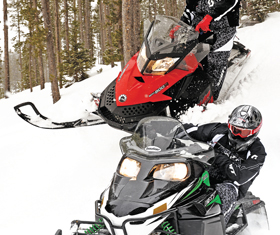
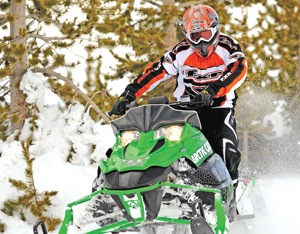
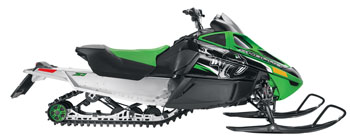
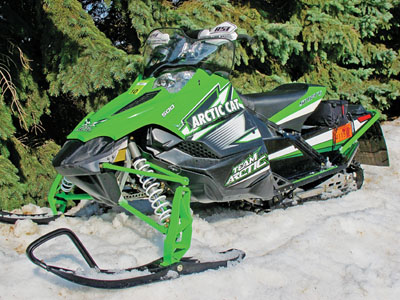
Looking for piston and rings for my son’s kitty kat it’s a 72 with the kawaski motor. Thought maybe you guys have some connections. Thanks Eric
My Dad has the Kitty Cat – serial number 001…. is there any interest in the vintage collector for this? He was an artic cat snowmobile dealer in the early 70’s….
I’m looking!! Please let me know!
i,ve got what i believe is a 1971 kitty cat serial #0093 with a clinton motor. I have no spark. cleaned all ends but looking for ignition parts
Need a carb for a 1997 kitty cat in a lower chain driven sprocket in pipe
What is the value of 99 Kitty Cat – almost perfect condition?
I just purchased a Kitty Kat because they are just darn cute. I’m not sure of the year but it runs great.